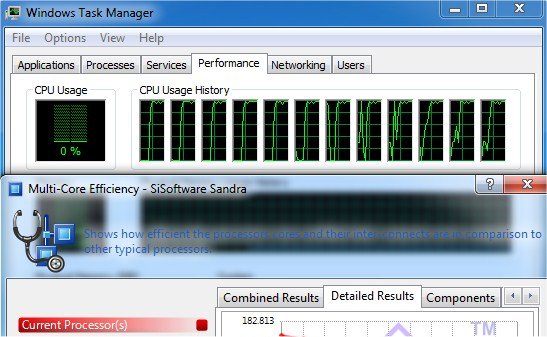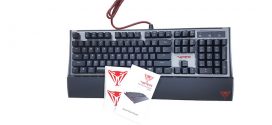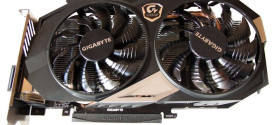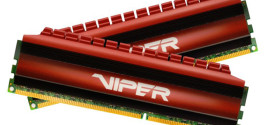Patriot Xtreme Viper Series features a custom aluminum and copper-core heatshield for greater heat dissipation. Made for the Intel P55 chipset, the memory runs at 2000MHz at 1.65V.
Introduction
We have seen a decline in the pricing of DDR3 memory over the last few months. The drop in the pricing means it is a good time for consumers to upgrade or add additional memory. The decline in the pricing also means that larger capacity DDR3 has become a more widely available — a pack of 2x4GB DDR3 is available for as low as $80. Of course, these are low speed memories, not designed for performance system.

Patriot has recently launched the Viper Xtreme DDR3 Xtreme Performance low-latency (9-10-9-27) memory running at speeds up to 2000MHz and 1.65V. The Patriot Viper Xtreme Series is the company’s high performance memory, designed for overclocking and those who need fast memory. Currently there are two speed to choose from : PC3-12800 (1600MHz) and the PC3-16000 (2000MHz). They come in 4GB, 6GB, 8GB, 12GB, and 24GB capacities for the Core i7 and Core i5 in both triple channel and dual-channel configuration.
PX538G2000ELK Viper xtreme Series DDR3 8GB 2000MHz
We have seen a decline in the pricing of DDR3 memory over the last few months. The drop in the pricing means it is a good time for consumers to upgrade or add additional memory. The decline in the pricing also means that larger capacity DDR3 has become a more widely available — a pack of 2x4GB DDR3 is available for as low as $80. Of course, these are low speed memories, not designed for performance system.

The memory is shipped in a black and red box which just screams performance.

Opening up the cardboard box reveals a plastic clamshell mold that is common with many memory packages. Luckily Patriot did not hot-seal the plastic so opening the package will not cause any cuts.

The Xtreme Viper features a unique heatsink design. A copper metal plate acting as a heatshield sits next to the memory chip, and an aluminum heatsink wraps around the copper metal and extrudes above the memory DIMM. Copper has a better thermal conductivity than aluminum, so having a piece of copper in direct contact with the memory chip will help with heat conduction. Patriot estimates that the 6 grams of the copper heatshield will enhance the cooling up to 5%.

It’s always nice to see manufacturers print the timing on the memory because it saves the trouble of looking up the supported timing when it comes to overclocking.
The black aluminum heat spreader extends slightly above the memory stick. It is not as tall as those found on larger memory modules such as the Super Talent, so despite its height, we do not think it will obstruct installation of large CPU heatsinks.
We received the PX538G2000ELK Viper Xtreme Series DDR3 8GB 2000MHz Enhanced Latency Kit. This is a 2x4GB pack that is designed for Intel Socket 1156 processors. Our review sample has a rated speed up to 2000MHz with 9-10-9-27 timings at 1.65V, the maximum voltage recommended by Intel. While our review sample is 2x4GB pack, users can find 2x2GB readily available as well.
The memory supports Intel XMP Profile 1.2, which means that if the motherboard supports such feature, it will automatic detect the speed and timing of the memory. Patriot warrants the memory for their limited lifetime warranty. The memory is tested with the Intel P55 chipset up to the specified speed, though it should work with the latest P67 chipset or the AMD 890 chipset without any issue. One thing to note is that due to the memory controller design on the P67 chipset, if users install the memory on a P67 board, it will only run at 1866MHz.
Normally we will dedicate a section for the overclocking, but with the Patriot Viper Xtreme, we could not get much out of the RAM. We raised the voltage to 1.885V and were able to push the memory to 2080MHz at 10-10-10-27-41-2T with the bus speed set at 260MHz and the multiplier set at 13. That’s as far as we could push ths memory. Bear in mind that current Intel and AMD systems have the memory controller built into the processor, so raising the memory speed will require raising the controller’s speed. Thus, user results can vary depending on how much headroom a user’s processor provides.
Testing & Methodology
| Test Rig | |
| Case Type | None |
| CPU | AMD Phenom II X6 1100T |
| Motherboard | ASUS Crosshair IV Extreme |
| Ram | Kingstone HyperX 1600
Patriot Xtreme Viper 2000MHz |
| CPU Cooler | Prolimatech Megahalem |
| Hard Drives | Seagate 7200.11 1.5TB |
| Optical | None |
| GPU | Asus HD 6870 |
| Case Fans | 120mm Fan cooling the mosfet CPU area |
| Docking Stations | None |
| Testing PSU | Cooler Master UCP 900W |
| Legacy | None |
| Mouse | Microsoft Intellimouse |
| Keyboard | Logitech Keyboard |
| Gaming Ear Buds |
None |
| Speakers | None |
Test Suite
| Benchmarks |
| Sandra 2011b |
| AIDA64 1.50 |
| PCMark Vantage X64 |
| 3DMark Vantage |
| AS SSD Benchmark |
aida64 v1.50
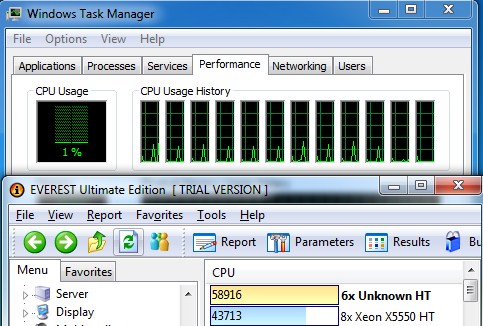
“AIDA64 Extreme Edition is a streamlined Windows diagnostic and benchmarking software for home users. AIDA64 Extreme Edition provides a wide range of features to assist in overclocking, hardware error diagnosis, stress testing, and sensor monitoring. It has unique capabilities to assess the performance of the processor, system memory, and disk drives. AIDA64 is compatible with all current 32-bit and 64-bit Microsoft Windows operating systems, including Windows 7 and Windows Server 2008 R2.”

In terms of memory copy speed, the Patriot Viper performs best at 2000MHz, followed by 1800MHz.
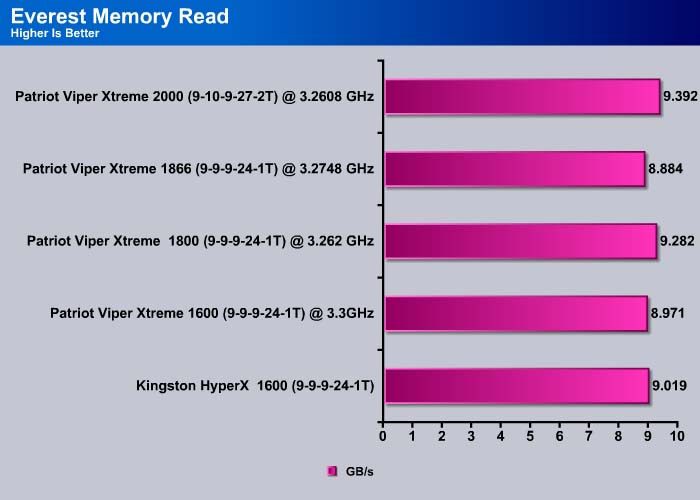
The Viper shows a very good read performance at 1800 and 2000MHz speeds. It scored 9.282 GB/s and 9.392 GB/s respectively.
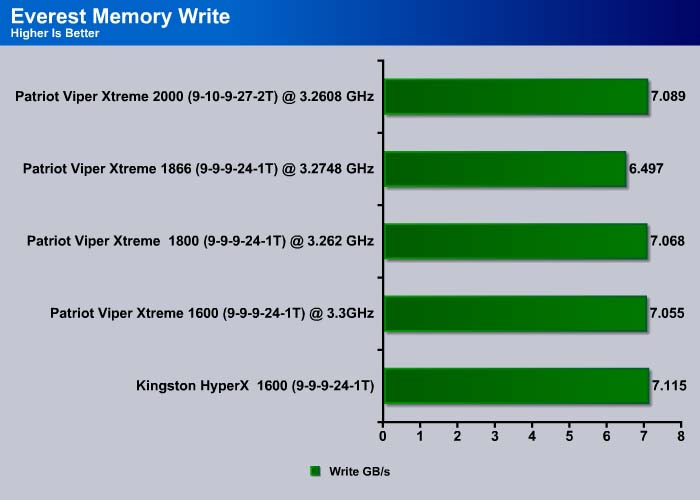
The Write speed on the Viper is a tad slower than the Kingston HyperX’s 7.115 GB/s. However, as we saw earlier, the memory still performs better at 2000MHz and 1800 MHz speeds.

The latency for the Viper Xtreme is quite good. Again, at 2000MHz and 1800MHz, it beats the Kingston HyperX’s 47.5 ns. However, at 1600MHz, the Kingston HyperX has a 1 nanosecond shorter latency.
Sisoft Sandra 2011b
“SiSoftware Sandra (the System Analyzer, Diagnostic and Reporting Assistant) is an information & diagnostic utility. It should provide most of the information (including undocumented) you need to know about your hardware, software and other devices whether hardware or software. It works along the lines of other Windows utilities, however it tries to go beyond them and show you more of what’s really going on. Giving the user the ability to draw comparisons at both a high and low-level. You can get information about the CPU, chipset, video adapter, ports, printers, sound card, memory, network, Windows internals, AGP, PCI, PCI-X, PCIe (PCI Express), database, USB, USB2, 1394/Firewire, etc.”


Similar to what we saw earlier, the Viper has the highest throughput at 1800MHz and 2000MHz with 13 GB/s and 12.8 GB/s throughput respectively. Sandra’s memory test also confirms what we observed with the AIDA64: at 2000MHz, the latency speed peaks at 76.1 ns, followed by 77.7 ns at 1800MHz. At 1600MHz, however, the Kingston HyperX is a tad faster.
PCMark Vantage
PCMark Vantage is the latest system benchmark tool from Futuremark. The benchmark consists of tests such as application launches, file searches, web browsing, video playback, photo editing, and gaming.

Considering what we observed about the Viper’s throughput, it is not a big surprise that we see the memory shows the best performance at 1800MHz. Here the system scored 7366 points in PCMark Vantage at 1800MHz.

PCMark Vantage’s Memory test suite shows the Viper Xtreme has the best performnace at 1800MHz. However, this test shows the 1866 MHz as the second highest score, followed by 1600 MHz, with 2000MHz taking the last place.

In the TV and Movies test, the system encodes video clips to Windows Media Center, and as expected, having a higher memory throughput shows its benefit at this task: the 2000MHz trounces all other speeds of memory.

Gaming test shows slightly a different result where we see the best score at 1600MHz. Since we had to tweak the multiplier in order to achieve other scores, we believe the difference in the performance is most likely due to the fact that the memory controller works best at its natively supported speed of 1600MHz for the lowest latency. Here we can see the 8GB of RAM has a slight benefit over the 4GB Kingston kit.

Vantage Music test involves transcoding music to Windows Media Player. It is not the most demanding task for modern systems. Surprisingly though, the Viper Xtreme has the worst score here at 1800MHz.

The Communication test involves light multi-tasking of data encryption, data compression, and web page rendering. The Viper Xtreme shows a commanding lead over the Kingston HyperX.

Productivity involves a very typical desktop scenario where users will multi-task between various applications, such as Office Suite and surfing the internet. Here the system shows the best performance at 1600MHz and 1866 MHz. However, if we examine the score closely, we can see that the difference in the score is most likely due to the CPU clockspeed, where the faster CPU speed yields a higher score.
Comparing the Kingston 4GB pack to the Viper 8GB pack, we can see the Viper Xtreme scores about 5% higher than the Kingston HyperX, indicating that having more memory is definitely a plus when it comes to multi-tasking.

The HDD test does not utilize memory as much as other tests, so the scores are not that different.
3DMark Vantage

For complete information on 3DMark Vantage Please follow this Link:
www.futuremark.com/benchmarks/3dmarkvantage/features/
This utility is still a synthetic benchmark, but one that more closely reflects real world gaming performance. While it is not a perfect replacement for actual game benchmarks, it has its uses. We tested our cards at the ‘Performance’ setting.

The higher the memory speed results in a greater performance in the 3DMark Vantage test. Here we can see the Patriot Viper scales up as the memory speed increases.

The 3DMark Vantage CPU test also scales up as the memory speed increases.

The GPU score shows similar scaling.
Conclusion
Considering that today’s systems have the memory controller built into the processor, the memory speed may seem to be less important. However, for overclockers, having a faster memory with tight timing and good throughput is still essential. In our test, the Patriot Viper Xtreme showed the highest throughput and lowest latency at frequencies of 1800MHz and 2000MHz. This makes the memory a good choice for Intel Socket 1156 processors and AMD Socket AM3 processors, where the controller on the processor will support such speeds with overclocking.
The Patriot PX538G2000ELK is currently selling at $159.99 at Newegg, which is slightly more expensive than some 2x4GB memory kits at slower speeds. However, the memory offers a good performance at voltages of 1.65V and is capable of running at 2000MHz with 9-10-9-27 timings. The memory will guarantee that users will not be bottlenecked by the memory bandwidth when it comes to overclocking. What we really loved about the Patriot Viper Xtreme is its relatively low profile heatspreader. While the heatsink is slightly taller than a standard heatspreader, it is not obtrusive and the copper plate should definitely help with heat dissipation.
| OUR VERDICT: Patriot Viper Xtreme P3-16000 – 2000MHz | ||||||||||||||||||
|
||||||||||||||||||
| Summary: The Patriot PX538G2000ELK is a good choice for those who need a good 2x4GB memory kit that supports 2000MHz speed. We award it the Bjorn3D Silver Bear Award. |
 Bjorn3D.com Bjorn3d.com – Satisfying Your Daily Tech Cravings Since 1996
Bjorn3D.com Bjorn3d.com – Satisfying Your Daily Tech Cravings Since 1996


